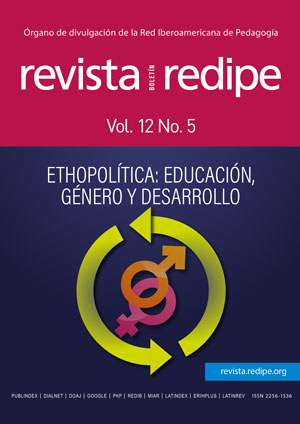Sexual and gender dissidences in school: Reproductive or transformative institution?
Main Article Content
Keywords
School, Heteronormativity, Cisnormativity, Teachers’ training, Queer pedagogy
Abstract
Based on a theoretical review, this text proposes and argues the dual nature of school, on the one hand it reproduces hetero-cis-normativity as a set of discourses and practices imbued on patriarchal culture that seek to produce heterosexual and cisgender lives; at the same time it deploys a series of pedagogical strategies that contribute to transform the traditional orders and codes around sexuality and gender, highlighting the importance of teachers’ training on the matter. The argumentation is developed in this order to conclude with the need to integrate critical perspectives from queer pedagogy to guarantee the inclusion of people who embody sexual and gender dissidence in school, while disturbing the social, cultural and political structures that have turned this institution into a fundamental space of socialization in the maintenance of the heterocis-normative social order.
References
Berry, K. (2018). LGBT bullying in school. A troubling relational story. Communication Education, 64(7), pp. 502-513. https:// doi.org/10.1080/03634523.2018.15061 37
Britzman, D. (1998). Is there a queer pedagogy? Or, stop reading straight. In Pinar, W. (Ed.). Curriculum: toward new identities, pp. 211-232. Garland Publishers.
Bodenhofer, C. (2019). Estructuras de sexogénero binarias y cisnormadas tensionadas por identidades y cuerpos no binarios: Comunidades educativas en reflexión y transformación. Punto Género, (12), pp. 101-125. https://doi. org/10.5354/0719-0417.2019.56250
Butler, J. [1990] (2007). El género en disputa. El feminismo y la subversión de la identidad. Paidós.
Caicedo, J. y Castillo, E. (2022). El racismo escolar. Debates educativos y crónicas. Universidad del Cauca.
Connell, R. & Messerschmidt J. (2005). Hegemonic masculinity: rethinking the concept. Gender & Society. 19(6), pp. 829-859. https://doi. org/10.1177/0891243205278639
Connell, R. (1996). Teaching the boys: new research on masculinity, and gender strategies for schools. Teachers College Record, 98(2), pp. 206-235.
DePalma, R. & Atkinson, E. (2010). The nature of institutional heteronormativity in primary schools and practice-based responses. Teaching and Teacher Education, 26, pp. 1669-1676. https://doi.org/10.1016/j. tate.2010.06.018
Dollimore, J. (1991). Sexual Dissidence: Augustine to Wilde, Freud to Foucault. Oxford University Press.
Epstein, D., O’Flynn, S. & Telford, D. (2003). Silenced sexualities in schools and universities. Trentham Books.
Flores, V. (2008). Entre secretos y silencios. La ignorancia como política de conocimiento y práctica de (hetero) normalización. Revista de Trabajo Social, (18), pp. 14- 21.
Gansen, H. (2017). Reproducing (and disrupting) heteronormativity: gendered sexual socialization in preschool classrooms. Sociology of Education, 90(3), pp. 255-272. https://doi. org/10.1177/0038040717720981
Gegenfurtner, A. & Gebhardt, M. (2017). Sexuality education including lesbian, gay, bisexual and transgender (LGBT) issues in schools. Educational Research Review, 22, pp. 215-222. https://doi. org/10.1016/j.edurev.2017.10.002
González, G. (2016). Teorías de la disidencia sexual: de contextos populares a usos elitistas. La teoría queer en América latina frente a las y los pensadores de disidencia sexogenérica. De Raíz Diversa, 3(5), pp. 179-200. https://doi.org/10.22201/ ppela.24487988e.2016.5.58507
Goodhand, M. & Brown, K. (2016). Heteronormativity in elementary schools: the hidden and evaded curricula of gender diversity. International Journal of School and Cognitive Psychology, 3(3), pp. 1-15. https://doi.org/10.4172/2469- 9837.1000188
Haddad, Z. (2019). Understanding identity and context in the development of gay teacher identity: perceptions and realities in teacher education and teaching. Education Sciences, 9(145), pp. 1-13. https://doi.org/10.3390/educsci9020145
Kitchen, J. & Bellini, C. (2012). Addressing lesbian, gay, bisexual, transgender, and queer (LGBTQ) issues in teacher education: teacher candidates’ perceptions. Alberta Journal of Educational Research, 58(3), pp. 444-460. https://doi.org/10.11575/ ajer.v58i3.55632
Luhmann, S. (2009). Queering/Querying pedagogy? Or, pedagogy is a pretty queer thing. In Pinar, W. (Ed.). Queer theory in education, pp. 120-132. Taylor & Francis.
Magnus, C. & Lundin, M. (2016). Challenging norms: University students’ views on heteronormativity as a matter of diversity and inclusion in initial teacher education. International Journal of Educational Research, 79, pp. 76-85. https://doi. org/10.1016/j.ijer.2016.06.006
Martin-Castillo, D., et al. (2020). School victimization in transgender people: A systematic review. Children and Youth Services Review, 119, pp. 1-16. https://doi.org/10.1016/j. childyouth.2020.105480
Pennell, S. (2016). Queering the curriculum: critical literacy and numeracy for social justice. (PhD. Dissertation). Chapel Hill: University of North Carolina.
Platero, R. (2014). TRANS*exualidades Acompañamiento, factores de salud y recursos educativos. Ediciones Bellaterra.
Preciado, P. (2019). Un apartamento en Urano. Crónicas del cruce. Anagrama.
Radi, B. (2020). Epistemología del asterisco: una introducción sinuosa a la Epistemología Trans*. En Maffia, D., et al. Apuntes Epistemológicos, pp. 107-121. Editorial de la Universidad Nacional del Rosario.
Rich, A. (1980). Compulsory heterosexuality and the lesbian existence. Signs, 5(4), pp. 631-660.
Robinson, J. & Espelage, D. (2012). Bullying explains only part of LGBTQHeterosexual risk disparities: Implications for policy and practice. Educational Researcher, 41(8), pp. 309-319. https:// doi.org/10.3102/0013189X12457023
Schmidt, S., et al. (2012). Recognition, responsibility, and risk: pre-service teachers’ framing and reframing of lesbian, gay and bisexual social justice issues. Teaching and Teacher Education, 28, pp. 1175-1184. https:// doi.org/10.1016/j.tate.2012.07.002
Serano, J. (2007). Whipping Girl: A transsexual woman on sexism and the scapegoating of femininity. Seal Press.
Stuff, D. & Graff, C. (2011). Increasing visibility for LGBTQ students: what schools can do to create inclusive classroom communities. Current Issues in Education, 14(1), pp. 1-24.
Sumara, D. & Davis, B. (2002). Interrupting heteronormativity: toward a queer curriculum theory. Curriculum Inquiry, 29(2), pp. 191-208.
Toomey, R., McGuire, J. & Russell, S. (2012). Heteronormativity, school climates, and perceived safety for gender nonconforming peers. Journal of Adolescence, 35, pp. 187- https://doi.org/196. 10.1016/j. adolescence.2011.03.001
Warner, M. (1991). Fear of a queer planet. queer politics and social theory. Social Text, 29, 3-17.
Werner, E. (2008). Homofobia y convivencia en la escuela. Universidad Pedagógica Nacional.
Wilkinson, L. & Pearson, J. (2015). Samesex sexuality and postsecondary outcomes: the roles of high school locale. Sociological Perspectives, 58(3), pp. 380-401. https://doi. org/10.1177/0731121415569283
Wilkinson, L. & Pearson, J. (2009). School culture and the well-being of samesex-attracted youth. Gender and Society, 23(4): pp. 542-568. https://doi. org/10.1177/0891243209339913
Wittig, M. (1992). The Straight Mind. Beacon Press
Worthen, M. (2016). Hetero-cis–normativity and the gendering of transphobia. International Journal of Transgenderism, 17(1), pp. 31-57. https://doi.org/10.1080 /15532739.2016.1149538



